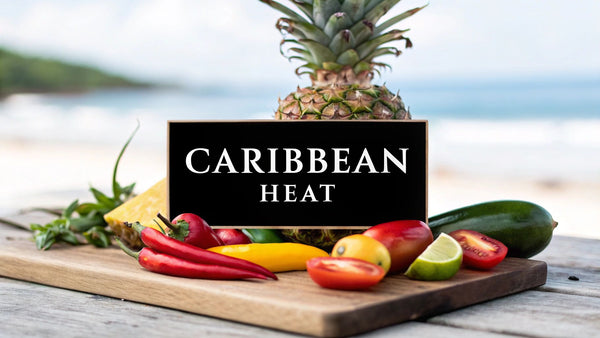Unleash the Caribbean Heat: A Culinary Adventure
Caribbean cuisine is famous for its vibrant flavors and intense heat. At the heart of this culinary magic is the art of crafting the perfect hot sauce. From Jamaica and Barbados to Trinidad and Puerto Rico, each Caribbean nation boasts its own unique version of this fiery condiment. These traditions, handed down through generations, reflect the diverse cultural influences that have shaped the region, from Indigenous Amerindian practices to European colonization and the introduction of African and Asian flavors. The hallmark of a truly exceptional Caribbean hot sauce is the delicate balance of heat, tang, and aromatic complexity, achieved through carefully selected ingredients and time-honored techniques.
The history of Caribbean hot sauces is closely tied to the arrival of the chili pepper from the Americas. It quickly became a staple ingredient in local cuisines. Over time, each island developed its own distinctive style, incorporating local fruits, herbs, and spices to create unique flavor profiles. Whether it's the fruity heat of the Scotch bonnet pepper, the earthy notes of culantro, or the tangy kick of fermented vegetables, each ingredient plays a crucial role in the symphony of flavors that define Caribbean hot sauces.
In this culinary exploration, we’ll journey across the Caribbean, uncovering the secrets behind seven iconic hot sauce recipes. Get ready to learn the techniques and discover the ingredients that will allow you to create authentic Caribbean flavors in your own UK kitchen.
Exploring Iconic Caribbean Hot Sauces
From the classic fiery Scotch bonnet pepper sauce to vibrant, fruity infusions and tangy fermented delights, these recipes will transform your meals. They'll add an authentic Caribbean touch to your culinary repertoire.
- Classic Scotch Bonnet Pepper Sauce: The quintessential Caribbean hot sauce, known for its intense heat and fruity undertones.
- Fruity Hot Sauce Infusions: Explore the vibrant flavors of tropical fruits like mango, papaya, and pineapple combined with chili peppers.
- Tangy Fermented Hot Sauces: Discover the complex flavors created through fermentation, adding a unique depth to your sauces.
Prepare to unleash the Caribbean heat and embark on a flavor adventure!
1. Traditional Scotch Bonnet Pepper Sauce
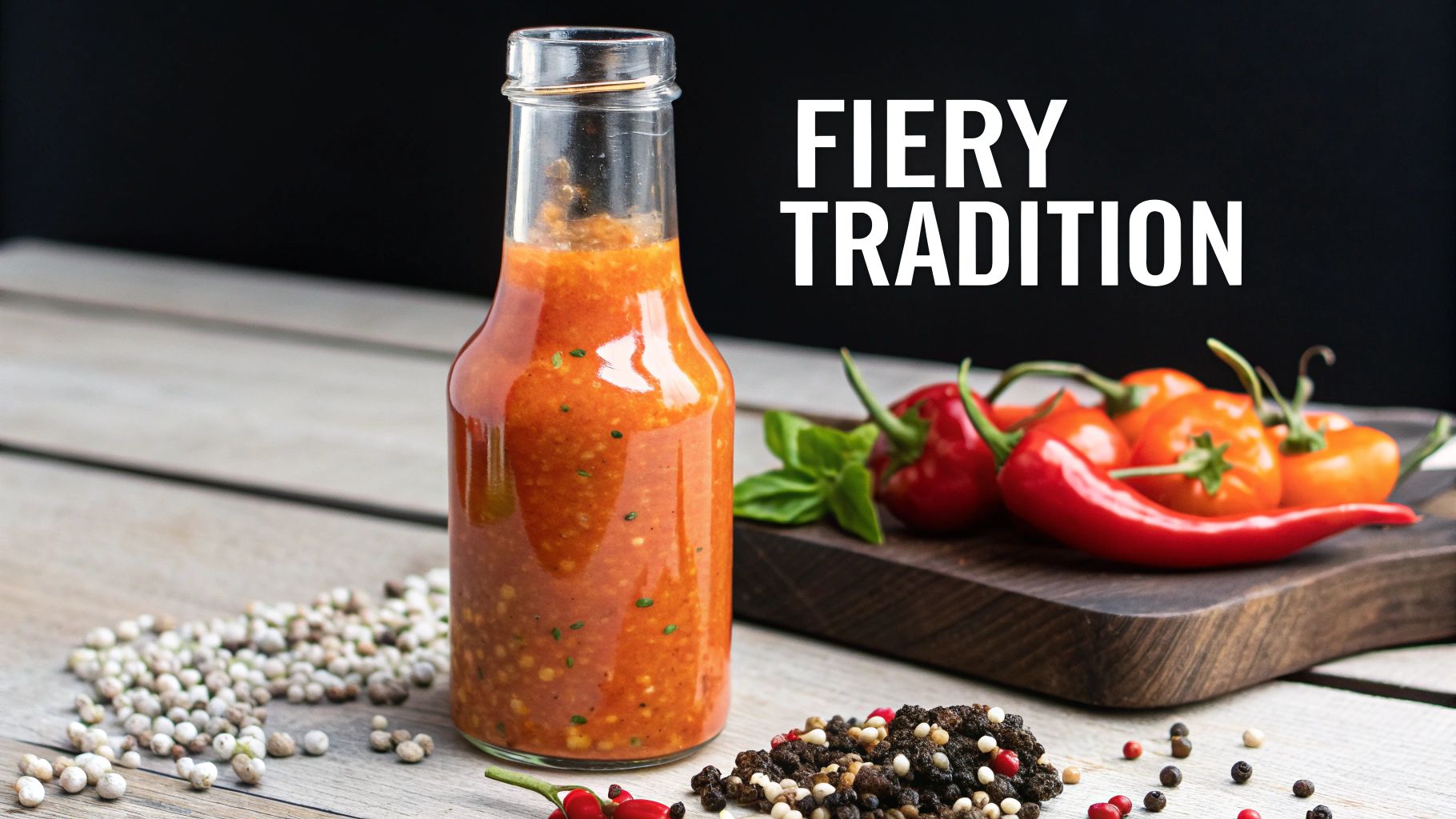
This authentic Caribbean hot sauce is a true classic, earning its top spot due to its iconic status and vibrant flavour. The key ingredient, the Scotch bonnet pepper, delivers a fiery heat (100,000–350,000 Scoville units) alongside distinctive fruity-sweet undertones. These are essential to Jamaican and other Caribbean cuisines. This bright orange-red condiment, with its slightly chunky texture, is much more than just heat. It's a burst of flavour that adds depth and complexity to any dish.
Traditional Scotch bonnet pepper sauce is typically made with fresh Scotch bonnets, vinegar, and a blend of aromatic spices. This creates a versatile sauce that’s equally delicious on jerk chicken or drizzled over rice and peas. Its thick consistency and vinegar base give it a long shelf life, making it a perfect pantry staple. In the UK, you can easily find bottled versions from brands like Grace Foods and Walkerswood, offering a convenient way to enjoy Caribbean flavours.
While finding authentic Scotch bonnet peppers might be tricky in standard UK supermarkets, they're becoming increasingly available in specialist Caribbean stores and online. This allows home cooks to recreate this fiery delight from scratch. UK-based Jamaican chef, Levi Roots, has also popularised the sauce through his culinary work, demonstrating its versatility and introducing it to a wider audience.
Features of Traditional Scotch Bonnet Pepper Sauce
- Heat level: Very hot (8–9/10)
- Flavour profile: Distinctive fruity-sweet undertones with serious heat
- Appearance: Bright orange-red colour, thick, slightly chunky texture
- Preservation: Long shelf life thanks to vinegar
Pros and Cons of Scotch Bonnet Pepper Sauce
Pros:
- Authentic Caribbean flavour
- Versatile – complements meat, seafood, rice dishes, and more
- Heat adjustable by removing seeds
- Simple ingredient list
- Preserves well for months in refrigeration
Cons:
- Extremely spicy for those with lower spice tolerance
- Requires careful handling of Scotch bonnets (gloves strongly recommended)
- Sourcing authentic Scotch bonnet peppers can be difficult outside of Caribbean/specialty markets in the UK
Tips for Using Scotch Bonnet Peppers
- Reduce the heat: Remove the seeds and membranes for a milder flavour while keeping the fruity notes.
- Enhance the flavour: Ferment the peppers for 1–2 weeks before blending for a richer, more complex flavour.
- Protect your skin: Always wear gloves when handling Scotch bonnets to prevent skin irritation.
- Allow it to mature: Age the sauce for at least one week in the refrigerator to let the flavours meld.
- Maximise shelf life: Store in sterilised glass bottles in the refrigerator.
You might be interested in learning more about various pepper types and their uses. This sauce is a must-try for anyone wanting to explore authentic Caribbean flavours. Its adaptability makes it a valuable addition to any hot sauce collection.
2. Bajan Pepper Sauce
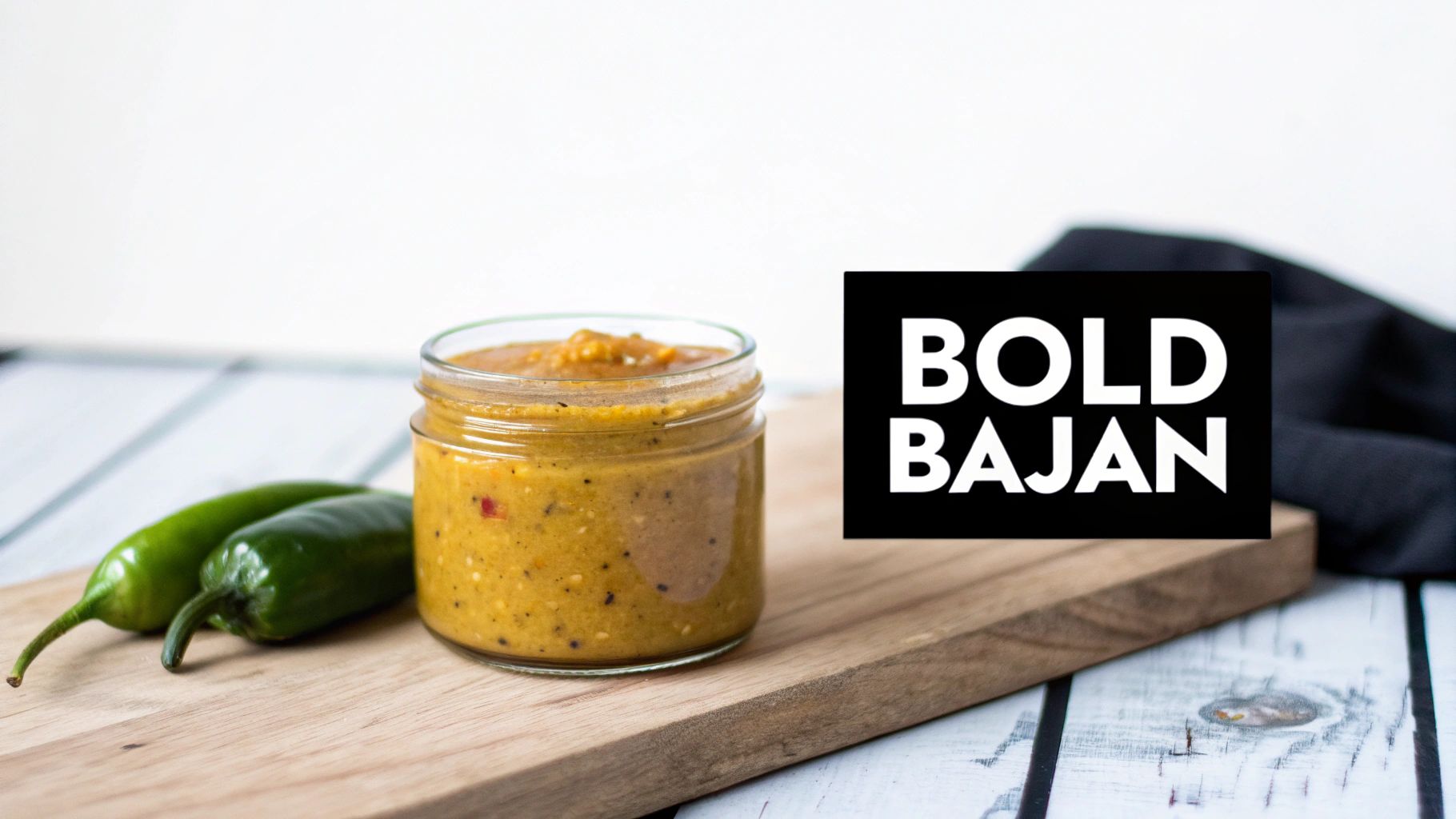
Bajan Pepper Sauce is a true culinary gem of Barbados, offering a distinctive take on Caribbean heat. Forget the typical pepper-vinegar blend. This sauce boasts a vibrant yellow-orange color thanks to its generous mustard base, resulting in a thicker texture that clings perfectly to food. The flavor profile is a delightful dance of fiery Scotch bonnet peppers, tangy mustard, and a touch of sweetness. This intriguing combination easily earns Bajan Pepper Sauce a coveted spot on our list for its unique flavor and versatility.
Rated at a 7/10 on the heat scale, it offers a satisfying warmth without being overwhelmingly spicy. The mustard acts as both a flavor enhancer and a buffer, allowing the fruity notes of the Scotch bonnet pepper to shine through. This complexity sets it apart from simpler Caribbean hot sauces and makes it a valuable addition to any hot sauce collection.
Bajan Pepper Sauce plays a vital role in Barbadian cuisine, acting as a key condiment and marinade. Imagine crispy flying fish sandwiches generously coated in the vibrant sauce, juicy jerk chicken infused with its tangy heat, or traditional dishes like cou-cou and flying fish elevated by a flavorful dollop.
While brands like Lottie's Hot Pepper Sauce and Aunt May's are readily available in the Caribbean, finding authentic Bajan Pepper Sauce elsewhere may require some effort. Specialty Caribbean grocers or online retailers are your best bet. The price might be slightly higher than standard hot sauces, but the unique flavor is well worth the investment. You might also find smaller, artisanal Bajan hot sauces emerging in new markets, reflecting the growing global appreciation for Caribbean cuisine. Chef Paul Carmichael, a renowned Caribbean cuisine expert, has also embraced this sauce, further boosting its international recognition.
Pros and Cons of Bajan Pepper Sauce
Pros:
- More manageable heat level compared to pure pepper sauces
- Thick consistency adheres well to food
- Versatile for marinades, table sauces, and more
- Distinctive flavor unlike other Caribbean sauces
- Good shelf stability
Cons:
- The strong mustard flavor may not suit everyone
- Requires a more complex ingredient list
- Authentic versions may be difficult to source outside the Caribbean
Tips for Making Your Own Bajan Pepper Sauce
- Balance: Tailor the mustard and pepper ratio to your preferred heat level.
- Mustard Choice: Dijon mustard adds complexity, while standard yellow mustard offers a more traditional Bajan flavor.
- Mellowing the Heat: Simmering the ingredients briefly before blending smooths the heat.
- Maturation: Allow the sauce to rest in the refrigerator for at least 5 days to develop its full flavor.
- Marinade Magic: Use this sauce as a marinade for chicken, fish, or tofu.
Whether you're a hot sauce enthusiast or just starting to explore the world of chili peppers, Bajan Pepper Sauce offers a truly unique and flavorful adventure. Its distinctive profile, versatility, and cultural significance make it a must-try for any food lover, especially those drawn to the vibrant flavors of the Caribbean.
3. Trinidad Pepper Sauce (With Culantro)
This vibrant green-yellow sauce isn't simply hot; it's a burst of flavor embodying Trinidadian cuisine. Unlike other Caribbean hot sauces, the Trinidad Pepper Sauce features the unique, pungent aroma and taste of culantro (also known as shadon beni or chadon beni). Often mistaken for cilantro, culantro delivers a more intense, almost peppery flavor crucial to the sauce's complex profile. Combined with the fiery Scotch Bonnet peppers and a blend of spices, it creates an unmatched taste.
The thinner consistency coats food beautifully, enhancing, not masking, your meal's flavors. It’s traditionally paired with Trinidadian street food, especially "doubles"—curried chickpeas between fried flatbread. Picture the soft bread, savory chickpeas, and the fiery, herbaceous kick—a true taste of Trinidad. But its versatility extends beyond street food; it's delicious on curries, roti, grilled meats, and even fish. Consider it a flavor enhancer for anything needing a boost.
Why This Sauce Stands Out
The Trinidad Pepper Sauce offers a unique herbal depth setting it apart from other Caribbean hot sauces. Its authentic Trinidadian flavor, driven by culantro, is a must-try for anyone seeking bold, complex tastes. The intense heat, balanced by fresh herbs and spices, delivers a layered sensory experience.
Features and Benefits
- Heat Level: Very hot (8/10)
- Distinctive Herbal Notes: From culantro, the star ingredient.
- Consistency: Thin, perfect for coating and dipping.
- Color: Vibrant green-yellow.
- Flavor Profile: Complex and layered.
- Pairs Well With: Chickpea dishes, curries, roti, grilled meats, and street food.
Pros and Cons
Pros:
- Unique herbal dimension.
- Versatile across dishes.
- Adjustable heat level.
- Authentic Trinidadian taste.
Cons:
- Culantro can be difficult to source in the UK.
- Shorter shelf life (1-2 months).
- Intense heat can potentially overpower other flavors.
Tips for Success
- Culantro Substitute: If unavailable, combine cilantro and a touch of rue.
- Texture: Pulse ingredients in a food processor for a traditional texture.
- Marinating: Marinate herbs in vinegar overnight to deepen the flavor.
- Storage: Refrigerate to maintain freshness.
Popularity and Evolution
Brands like Matouks and chefs like Debbie Sarduy have popularized this sauce. While traditionally homemade, its growing popularity has increased commercial availability. However, imported versions can be pricey.
This sauce isn't just a condiment; it represents Trinidadian culture and fresh ingredients. Whether you’re a spice lover or a curious foodie, the Trinidad Pepper Sauce with Culantro is a must-try.
4. Pineapple Habanero Hot Sauce
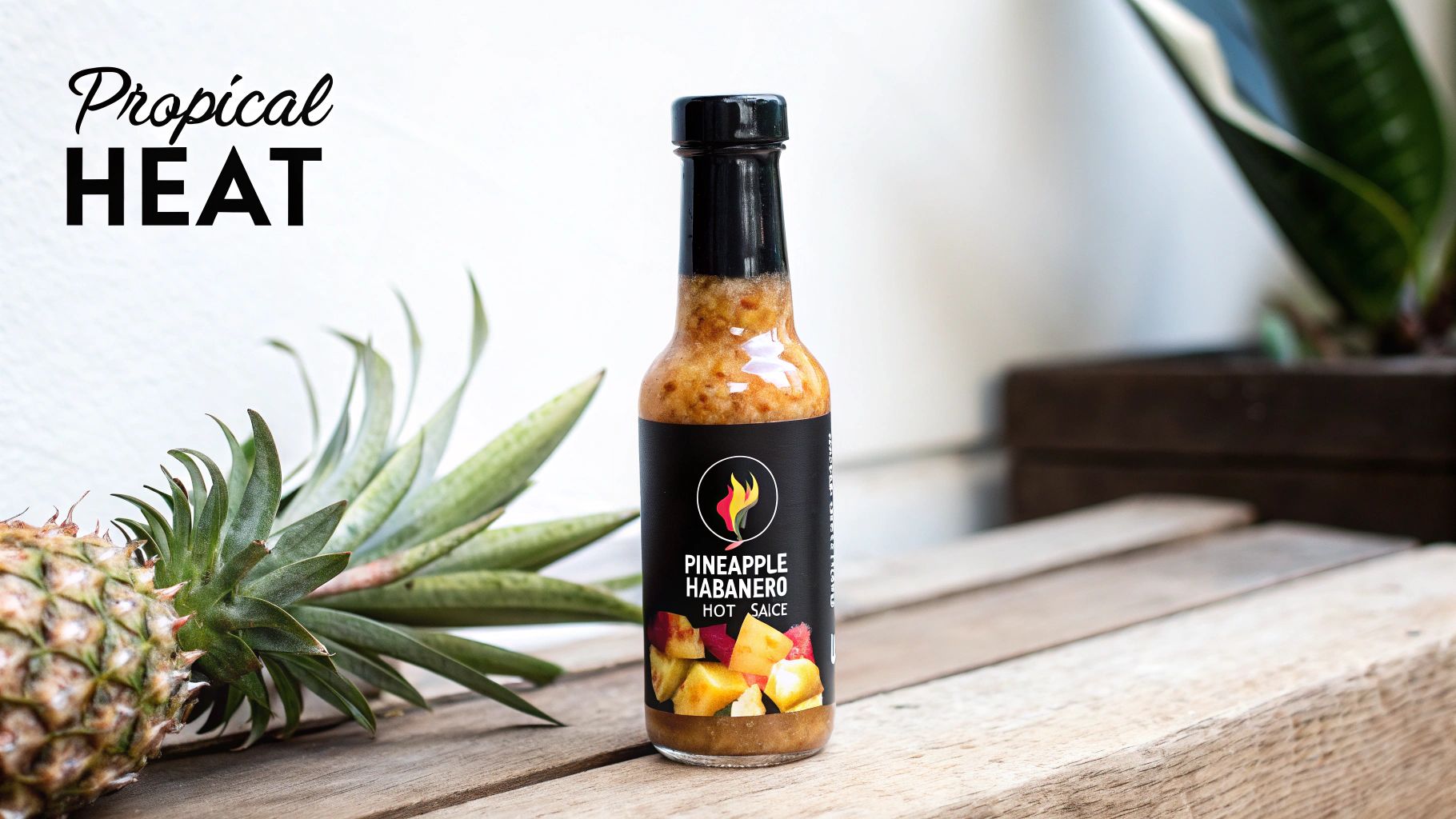
This Caribbean-inspired hot sauce balances the intense heat of the habanero pepper with the sweetness of fresh pineapple. The result is a delicious sweet and spicy flavor (6-7/10 on the heat scale) that complements grilled meats, seafood, or even works well as a dipping sauce. Its vibrant yellow-orange color and slightly thicker consistency give a glimpse of the exciting flavors within.
This sauce represents a modern take on Caribbean flavors, using local tropical fruits to achieve a more complex and balanced taste. While not strictly traditional, it highlights the prominent tropical fruit notes of the pineapple, adding a unique element to any dish.
The growing popularity of this style of hot sauce can be attributed to innovators like Baron West Indian Hot Sauce, who pioneered the combination of fruits and peppers. Brands like Tropical Pepper Co. have solidified its presence in the market, while chefs such as Norman Van Aken, renowned for his Caribbean fusion cuisine, have demonstrated its potential in fine dining.
The appeal lies in the manageable heat level balanced by the fruit's sweetness, making it an excellent introduction to hotter sauces. Its versatility as both a sauce and a marinade, especially with grilled pork and chicken, expands its appeal even further. For more inspiration and recipes, you might find Spicy Rye's site collections helpful.
Pros of Pineapple Habanero Hot Sauce
- Balanced Heat: Offers a more approachable heat balanced by the pineapple's sweetness.
- Pairs Well with Grilled Meats: Especially delicious with grilled meats, particularly pork and chicken.
- Sweet and Spicy Combination: Appeals to those who enjoy the combination of sweet and spicy flavors.
- Versatile Use: Can be used as both a sauce and a marinade.
- Added Complexity: Introduces a layer of fruit complexity to the traditional pepper sauce concept.
Cons of Pineapple Habanero Hot Sauce
- Less Traditional: Not as traditional as vinegar-based Caribbean hot sauces.
- Shorter Shelf Life: Due to the fruit content, it may have a shorter shelf life.
- Sweetness Not for Everyone: The sweetness might not be ideal for hot sauce purists.
Tips for Making Your Own Pineapple Habanero Hot Sauce
- Roast the Pineapple: Roasting pineapple chunks before blending intensifies the flavor and creates a caramelized note.
- Add Rum: Incorporate a touch of rum for a true Caribbean taste.
- Cook After Blending: Cooking the mixture after blending helps reduce it and creates a thicker consistency.
- Balance the Acidity: A squeeze of fresh lime juice helps balance the sweetness and acidity.
- Use as a Glaze: This sauce works wonderfully as a glaze during the last few minutes of grilling.
While the price and availability of pre-made pineapple habanero hot sauces can vary, you can often find them in specialty food stores, online retailers, or even some larger supermarkets. Making your own allows you to control the ingredients and heat level, providing a rewarding culinary adventure. This pineapple habanero hot sauce earns its place on this list for its unique flavor profile, versatility, and representation of the evolving world of Caribbean hot sauces.
5. Jamaican Jerk Hot Sauce
Jamaican Jerk Hot Sauce isn't just any hot sauce; it's a true culinary adventure. This complex condiment embodies the authentic flavors of Jamaica's famed jerk tradition, moving beyond mere heat to offer a symphony of spices and aromatics. Its distinctive dark brown hue, speckled with spices, hints at the rich depth of flavor it holds. This isn't a sauce for the timid; with a heat level of 7-8/10, it certainly packs a punch. However, that heat is beautifully balanced by the signature jerk spices: allspice, thyme, cinnamon, and nutmeg. This complexity is precisely what elevates it above single-note hot sauces and secures its spot on this list.
The history of jerk seasoning is deeply embedded in Jamaican culture, originating with the indigenous Taino people and evolving over centuries. This liquid version offers a convenient way to enjoy those profound, layered flavors. Brands like Walkerswood, a premier Jamaican jerk producer, and Grace Foods have made authentic jerk sauce readily accessible in the UK. You can often find them in supermarkets like Tesco, Sainsbury's, and specialist Caribbean grocers. Chef Levi Roots, with his Reggae Reggae Sauce, further popularized jerk flavors, bringing them into mainstream British cuisine. You can even discover variations on jerk sauces from smaller producers at local and farmers' markets, each offering their unique flavor profiles and spice blends.
Versatility of Jamaican Jerk Hot Sauce
Jamaican Jerk Hot Sauce's versatility is truly remarkable. It isn't simply a condiment for drizzling over finished dishes, though it excels in that role, particularly with chicken, pork, and fish. Its medium-thick consistency makes it a superb marinade, enabling the complex flavors to permeate the meat. Diluted with a little oil, it transforms into a flavorful basting sauce, ideal for grilling or roasting. Imagine succulent jerk chicken, marinated overnight, its skin caramelized and infused with fragrant spices.
Pros and Cons
Pros:
- Provides authentic jerk flavor in a convenient bottle
- Multifunctional as a marinade, basting sauce, or condiment
- Deep, complex flavor profile surpasses single-note hot sauces
- Pairs exceptionally well with various proteins, especially chicken, pork, and fish
Cons:
- Replicating authentic jerk sauce from scratch can be difficult given the complex ingredient list
- The robust flavor may overpower delicate dishes
- Not as adaptable as simpler, single-note hot sauces
Tips for Enhancing Flavor
- Toast whole spices before grinding to amplify their depth and aroma
- Opt for fresh thyme over dried for the most genuine Jamaican jerk flavor
- For marinades, let the meat marinate for 24-48 hours for complete flavor absorption
- Explore its use as both a marinade (diluted with oil) and a finishing sauce
- Store homemade jerk sauce in the refrigerator for up to 3 months
For those craving an authentic taste of Jamaica, this sauce offers a convenient path to culinary paradise. Whether you're a seasoned home chef or an adventurous foodie, exploring Jamaican Jerk Hot Sauce is a rewarding experience. While finding authentic jerk vendors like those in Boston Bay, Jamaica's jerk center, might be challenging in the UK, replicating the experience at home is achievable with high-quality jerk hot sauce. Remember to adjust the heat level and application to complement your palate and the dish you're preparing.
6. Pepper Vinegar (Puerto Rican Pique)
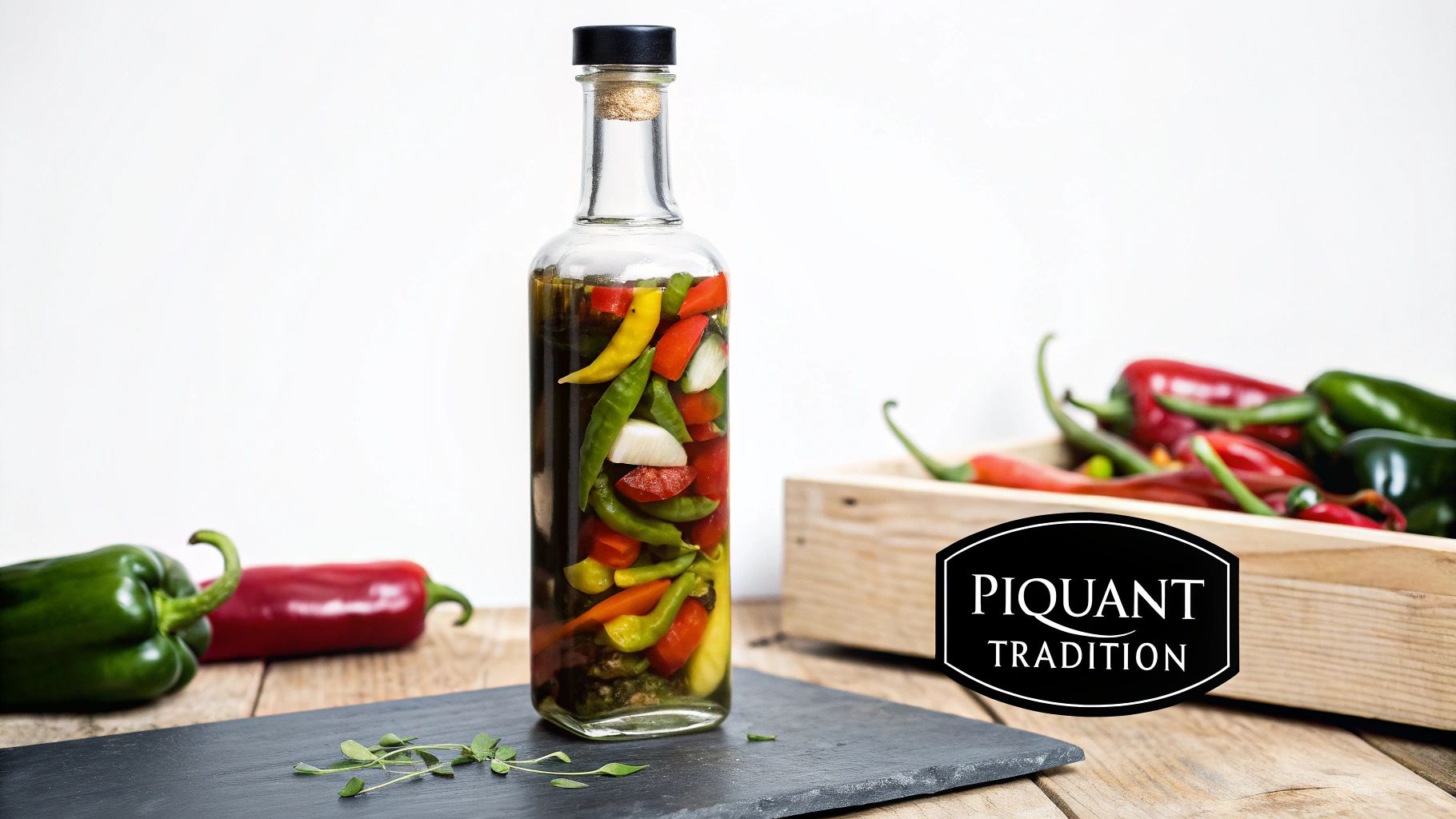
Pepper vinegar, or pique as it's known in Puerto Rico, is a testament to the power of simple ingredients. This vibrant condiment, a staple of Puerto Rican cuisine, delivers a clean, fiery kick that elevates a wide range of dishes, from fried snacks to hearty stews. Unlike many Caribbean hot sauces that rely on blended ingredients, pique features whole peppers steeped in vinegar. This creates a visually appealing and intensely flavorful infusion.
Pique is defined by its straightforward preparation. Hot peppers, often aji dulce or Scotch bonnets, are submerged in vinegar along with optional aromatics like garlic, onion, or oregano. This process develops a two-pronged flavor profile: the sharp acidity of the vinegar combined with the potent heat of the chilies. The result is a clear to slightly colored liquid punctuated by the vibrant hues of the peppers.
The versatility and longevity of pique are key to its appeal. The heat level can be adjusted based on the peppers used, ranging from a moderate 5/10 with milder varieties to a fiery 8/10 with Scotch bonnets or habaneros. As you use the pique, simply replenish the bottle with more vinegar. This creates a perpetually refillable hot sauce that can last for years.
While pique may not offer the complex flavor profiles of cooked or blended sauces, its clean, bright flavor is highly valued. This vinegar-forward profile cuts through rich dishes and adds a refreshing zing. It acts as a fiery counterpoint to the often heavy flavors found in Caribbean cuisine.
Pros and Cons of Pique
Here's a quick breakdown of the advantages and disadvantages:
Pros:
- Simple to make: Requires minimal equipment and ingredients.
- Continuously replenishable: Easily maintain your supply by adding more vinegar.
- Clean, bright flavor: Free of additives or thickeners.
- Extremely long shelf life: Enjoy your pique for years.
- Multipurpose: Perfect for cooking, finishing dishes, or using at the table.
Cons:
- Less complex: Offers a simpler flavor profile compared to cooked or blended sauces.
- Primarily heat and acidity: May lack nuanced flavor for some.
- Vinegar-forward: The sharpness might be too intense for some palates.
Tips for Making Your Own Pique
Here are some tips to help you create the perfect pique:
- Pierce the peppers: Creating a small hole in each pepper allows for better vinegar infusion.
- Vinegar choice: White vinegar delivers a traditional taste, while apple cider vinegar offers a slightly milder flavor.
- Ageing: Allow the pique to infuse for at least two weeks for optimal flavor development.
- Replenishing: Top up the vinegar as needed to maintain your supply.
- Storage: Store at room temperature for easy access.
Pique is rooted in traditional Puerto Rican home cooking, passed down through generations. Restaurants like El Jibarito in Old San Juan, known for their potent house pique, and chefs like José Enrique, a prominent ambassador of Puerto Rican cuisine, have further popularized this condiment. While readily available in specialist Latin American shops in the UK, making your own pique is incredibly easy and satisfying. The minimal cost of ingredients makes it a budget-friendly way to add a fiery Caribbean touch to your meals.
7. Haitian Pikliz
Pikliz is far more than just a hot sauce. It's a vibrant condiment essential to Haitian cuisine. This spicy, tangy, and crunchy relish offers a complex flavor profile. Built on a base of shredded cabbage, carrots, and Scotch bonnet or habanero peppers pickled in vinegar, it complements a wide range of dishes. Unlike many other Caribbean hot sauces that primarily focus on heat, pikliz adds a substantial textural element, acting as both a sauce and a relish.
Pikliz is the perfect counterpoint to rich, savory Haitian staples. Dishes like griot (fried pork) and tassot (fried meat) benefit from its acidity and satisfying crunch, cutting through the fattiness. Its popularity has spread beyond Haiti, thanks to chefs like Stephan Berrouet Durand, a prominent ambassador of Haitian cuisine. Figures like Madame Giselle, known for her celebrated pikliz recipe in Port-au-Prince, have also helped introduce pikliz to a wider audience.
These culinary champions have showcased pikliz's versatility and unique flavor. For further exploration of hot sauces and culinary resources, you might find the Spicy Rye's Site Map helpful. Traditionally prepared by home cooks in Haiti, pikliz is increasingly available in Caribbean markets and specialty shops in the UK. Pricing varies, but its 2-3 month refrigerated shelf life makes it a worthwhile addition to your pantry.
Understanding the Distinctive Qualities of Pikliz
One of pikliz’s key features is its textural complexity. This comes from the finely shredded vegetables, giving it a satisfying bite and setting it apart from smoother, blended hot sauces. Its vibrant color also makes it visually appealing. The mix of greens, oranges, and reds from the cabbage, carrots, and peppers brightens any plate. While pikliz certainly packs a punch (heat level 7-8/10), you can adjust the heat by using more or fewer peppers.
Pros:
- Provides both heat and texture
- Excellent shelf life (2-3 months refrigerated)
- Balances rich, savory dishes
- More nutritious than typical pepper sauces
- Versatile across different cuisines
Cons:
- Requires refrigeration
- Cabbage can soften slightly over time
- More preparation involved compared to blended sauces
Tips for Making Pikliz
- Slice vegetables paper-thin for ideal texture and quicker pickling.
- Allow the pikliz to marinate for at least 24 hours before serving to allow the flavors to meld.
- Ensure the vegetables are submerged in the vinegar solution for even pickling.
- Adjust the heat level by adding more or fewer peppers according to your preference.
- Include a small amount of shredded salt cod for an authentic touch, a traditional ingredient in some recipes.
Pikliz earns its place on this list due to its unique combination of heat, texture, and flavor. These qualities distinguish it from ordinary hot sauces. It's a versatile condiment that enlivens any meal and showcases Haiti's rich culinary heritage.
Caribbean Hot Sauce Recipes – 7-Point Comparison
| Recipe | Process Complexity (🔄) | Resource Intensity (⚡) | Expected Impact (📊) | Ideal Use Cases (💡) |
|---|---|---|---|---|
| Traditional Scotch Bonnet Pepper Sauce | Moderate – Requires careful handling and optional fermentation | Moderate – Needs authentic Scotch bonnets and basic aromatics | High – Delivers authentic, fiery heat with fruity undertones | Versatile on meats, seafood, and rice dishes |
| Bajan Pepper Sauce | Moderate – Balancing mustard with pepper requires attention | Moderate – Involves specific Bajan ingredients like yellow mustard | Medium-High – Offers tangy mustard-forward flavor with a smoother heat | Excellent for flying fish, chicken, and marinades |
| Trinidad Pepper Sauce (with Culantro) | Moderate to Advanced – Must balance herbal freshness with heat | High – Culantro can be hard to source outside the Caribbean | High – Provides a unique herbal and layered heat profile | Ideal for street foods, curries, roti, and doubles |
| Pineapple Habanero Hot Sauce | Moderate – Involves roasting pineapple and balancing sweet-spicy elements | Moderate – Uses tropical fruits and peppers commonly available | High – Achieves a dynamic fusion of sweet and spicy flavors | Perfect for grilled meats, dipping sauces, and marinades |
| Jamaican Jerk Hot Sauce | Advanced – Complex blend of multiple spices and aromatics | High – Requires an array of specialized jerk spices | High – Captures deep, layered jerk flavors with aromatic intensity | Best for marinating, basting, and authentic jerk dishes |
| Pepper Vinegar (Puerto Rican Pique) | Easy – Simple infusion method with minimal processing | Low – Few, widely available ingredients | Medium – Delivers a clean, vinegar-forward heat with long shelf life | Ideal as a table condiment and cooking finish |
| Haitian Pikliz | Moderate – Requires precise slicing and quick pickling techniques | Moderate – Uses basic vegetables and hot peppers | Medium-High – Combines crunch, tang, and heat for a distinctive taste | Excellent as a side or accompaniment for fried and savory dishes |
Embrace the Fire: Your Caribbean Hot Sauce Journey Begins
From the intense heat of Scotch bonnets in classic pepper sauces to the layered tang of jerk-infused creations, these 7 Caribbean hot sauce recipes offer a glimpse into the diverse and flavorful world of Caribbean cuisine. Whether your palate leans towards the bright citrus notes of a Bajan pepper sauce or the earthy, herbal kick of Haitian Pikliz, you now have the tools to create vibrant, flavorful heat in your own kitchen.
Recall the essential principles we’ve discussed: balancing heat with acidity and sweetness, exploring various peppers and aromatics, and tailoring recipes to your liking. Feel free to experiment with ingredients like tropical fruits, fresh herbs, and spices such as allspice and ginger to develop your signature sauce. As you progress, you'll master the art of balancing flavors and crafting hot sauces that perfectly enhance your favorite dishes.
The world of hot sauce is dynamic, with innovative flavor combinations and ingredients constantly emerging. Fermented hot sauces, unique pepper varietals, and creative pairings are just a few of the trends influencing the future of these fiery condiments. By embracing curiosity and experimenting with new techniques, you can continue to hone your hot sauce skills and discover exciting new flavor profiles.
Key Takeaways
- Fresh ingredients are essential for creating vibrant Caribbean hot sauces.
- Balance heat, acidity, and sweetness for an optimal flavor profile.
- Don't hesitate to experiment and customize recipes to suit your taste.
- Explore different pepper varieties and aromatic ingredients.
Ready to elevate your dishes with authentic Caribbean flavors without the effort of making your own? Spicy Rye's delivers bold, Caribbean-inspired heat crafted with real ingredients and without any artificial thickeners or preservatives. From our Hot Honey Pepper Sauce to our Chilli Vinegar Collection, we offer small-batch condiments designed to bring a taste of the islands to your table. Discover the flavor that will keep you coming back for more at Spicy Rye's.
Article created using Outrank

